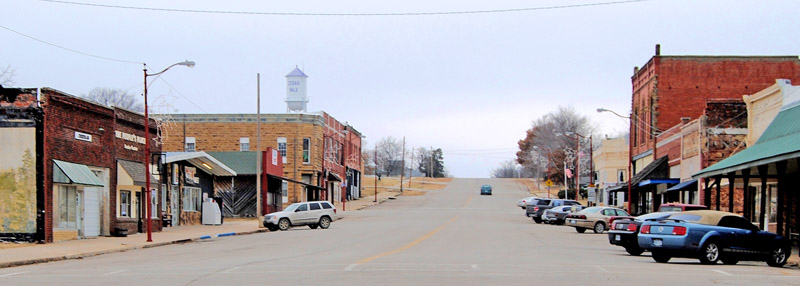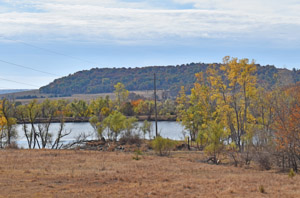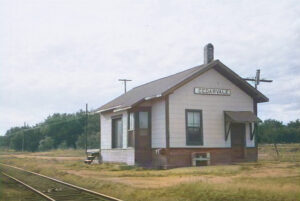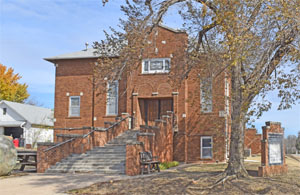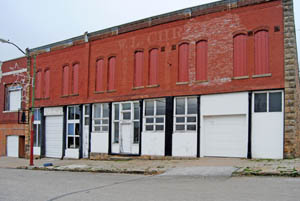Cedar Vale, Kansas, is a small town situated in Jefferson Township, near the western boundary of Chautauqua County. As of the 2020 census, the city’s population was 476, and it had a total area of 0.76 square miles, all of it land.
Cedar Vale dates back to the arrival of J.R. Marsh, a 25-year-old New Yorker, who left Emporia, Kansas, in November 1869, journeying toward the southwest in the hope of finding somewhere in the southern part of Kansas a place of settlement. After several days of wandering, he arrived at the Valley of the Big Caney River, and being impressed with its beauty and fertility, he decided to spend a few days exploring it.
He determined that the present location of Cedar Vale would be ideal for a townsite and located claims for himself and his friends. Other enterprising settlers began to arrive, and a town company was organized in 1870.
The townsite was located on unoccupied land, which had to be deeded to the company before it could be held. Accordingly, it fell upon E.W. Davis, one of the company, to file upon the land and to procure a deed, and he was to turn over to the company as soon as this was complete. When it came time for the property transfer, some dissension had arisen within the company, and Davis refused to deed the land to them. This refusal caused much indignation among the members who had no legal remedy. A resort to physical force was determined, and he was only persuaded to do so under the threat of hanging.
The name of Cedar Vale was adopted because of the Cedars growing along the creek. The town was advertised in the Eureka Herald, a paper printed at Eureka, Greenwood County. The first post office was established on May 2, 1870, with J.R. Marsh as postmaster. The first building was a store room erected by J.R. Marsh, Charles Snyder, and O.C. Hill, in which they opened a small stock of goods and where the post office was located. The first Fourth of July celebration took place in 1870, with an attendance of 1,000 people or more. The following structures were built: a hotel by the town company, and a store erected by Riley Bros. Several new general stores, two blacksmith shops, another hotel, a drug store, a millinery store, and a number of shops for various goods completed the improvements for the year 1870.
The town grew rapidly and soon outstripped Osrow, its rival, located four miles down the Big Cheney River. A grist mill was built in 1871 by D.F. Taber and operated using water power. A school district for the town of Cedar Vale and the immediate vicinity was organized on May 30, 1871.
A preliminary meeting was held to elect a School Board, and a petition was circulated, asking signers to vote on whether the district should issue bonds for the construction of a schoolhouse. The election was held on September 21, 1871, resulting in a margin of 21 votes in favor of the bonds. Bonds were issued immediately, and the contract for the erection of a schoolhouse, costing $700, was awarded to Bennett & Smith. The building was erected during the winter and spring, and on April 30, 1872, after some discussion over the defects in the construction of the house, it was accepted by the board.
The first school in the village was taught by Miss Lizzie Conkling in the summer of 1872, and was held in the new school building, with an attendance of 33 students, 14 of whom were boys, and 19 girls. The first religious services were held in the same year by “Old Father Record” in the school building.
By 1878, Cedar Vale had a flour mill, a sawmill, and a school building in which the Methodist Episcopal, Christian, and Universalist denominations worshipped. The town also boasted three attorneys, three doctors, a druggist, four general stores, grocery store, a hardware store, a meat market, a livery, a photographer, two milliners, a boots and shoes maker, a dressmaker, two carpentry companies, two wagonmakers, two harnessmakers, two blacksmiths, two hotels, two two confectioners, and three livestock men. Its exports were principally wheat and livestock. A stagecoach line ran daily to Independence and triweekly to Winfield, delivering the mail to Charles R. Pollard, the postmaster.

Vintage Cedar Vale, Kansas Main Street, circa 1890.
In 1880, the old mill was torn away and replaced with a commodious new one, the best of the kind in the county. It was powered by both water and steam, and contained two runs of buhrs.
By 1881, the school district contained 151 students of school age, 126 of whom attended school.
A commodious new school building was erected in the fall of 1882, at a cost, including furniture and supplies, of $1,500, and was a very handsome building, constructed of unchiseled sandstone. It is one story high, comprising but a single large room.
In 1884, Cedar Vale was incorporated by an act of the Kansas legislature. The same year, the Cedar Vale Star newspaper was established in 1884 and continued to be published for the next decade.
A railroad line was built in 1886 by an Atchison, Topeka & Santa Fe Railroad subsidiary, the Chicago, Kansas, and Western Railroad. All through 1886, construction crews for the Chicago, Kansas & Western Railroad and the Denver, Memphis & Atlantic Railroad, a Missouri Pacific subsidiary, raced one another westward through Chautauqua County, each vying to beat the other to the Cowley County line. The Denver, Memphis & Atlantic Railroad reached Cedar Vale at the county line first and then continued westward toward Dexter and Winfield. Finding little reason to share the same territory with the Missouri Pacific Railroad, the Atchison, Topeka & Santa Fe Railroad terminated construction at Cedar Vale. Thereafter, the Santa Fe operated the line as the Cedar Vale Branch, with the cattle town of Elgin, located on the Oklahoma border, generating most of the traffic. The Cedar Vale Branch railroad line carried considerable stock car traffic, with grass-fattened cattle being shipped from Elgin to Kansas City.
Cattle shipments peaked in about 1909 on the Cedar Vale Branch railroad line.
By 1910, Cedar Vale was the second-largest town in Chautauqua County. At that time, it had the best public schools, churches of all the leading denominations, two banks, a weekly newspaper called The Commercial, natural gas for lighting and heating purposes, telegraph and express offices, an international money order post office with three rural routes, and a population of 948.
Cedar Vale’s population reached its peak at 1,044 in 1920. In the following decades, its population gradually declined.
The Cedar Vale branch of the Atchison, Topeka & Santa Fe Railroad limped into the early years of the Great Depression before the railroad finally petitioned the Interstate Commerce Commission to abandon the line between Havana and Cedar Vale. Although the line was removed prior to World War II, the old roadbed remains evident throughout much of the alignment.
Today, the community is served by the Cedar Vale USD 285 public school district. During the school year, the community gathers to cheer on the school’s volleyball, football, and basketball teams as they head into victory. Christmas provides the music department a chance to shine during the vocal/instrumental program.
The City operates a public swimming pool. Kids’ summer baseball/softball gives the kids an opportunity to excel in summer sports. The Labor Day Parade is one of its best community events. Also included in the festivities is a 5K fun run, egg toss, and ranch rodeo.
The city features an outstanding museum housed in the old Adams Mercantile building.
Cedar Vale is located just south of US Highway 166 in western Chautauqua County. It is approximately 20 miles west of Sedan, the county seat.
Kathy Alexander/Legends of Kansas, July 2025.
Also See:
Chautauqua County Photo Gallery
Sources:
1878 Gazetteer and Business Directory, R. L. Polk & Co.
Abandoned Rails
Blackmar, Frank W.; Kansas: A Cyclopedia of State History, Vol I; Standard Publishing Company, Chicago, IL 1912.
City of Cedar Vale
Cutler, William G.; History of Kansas; A. T. Andreas, Chicago, IL, 1883.
Wikipedia

